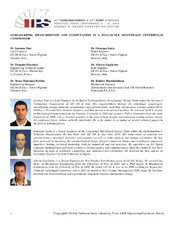| dc.description.abstract | Great interest is being paid by Oil & Gas industry to the design of high speed and high pressure ratio centrifugal compressors. Static and dynamic stresses are becoming higher and, under critical conditions, aerodynamic forcing may lead to impeller high cycle fatigue failures. Thorough aeromechanics knowledge is hence necessary for the advanced design of centrifugal compressors, to ensure reliability and life-time. Open impellers, which are commonly used for high speed applications, may be prone to relatively high vibration levels, due to aerodynamic excitations present in the flow field. Indeed, resonant crossings with forcing functions are in some cases unavoidable in variable speed machines since a wide speed range results in a wide frequency range of rotor-stator interactions, as well as flow-field circumferential distortions, occurring at multiples of the impeller excitations. Impeller forcing amplitudes and aeromechanical damping both contribute to vibratory response levels and must be properly predicted. This paper is focused on the aerodynamic damping prediction. A comprehensive study was undertaken to develop and validate aerodynamic damping prediction capability for open impellers for the operating conditions and mode shapes of interest. An extensive experimental campaign was conducted on a full scale multistage compressor equipped with transonic unshrouded impellers instrumented with strain gauges connected to a telemetry system. The strain gauge data are compared to the CFD (Computational Fluid Dynamics) predicted damping for blade and disk modes and show good agreement. The present paper describes the challenges related to aerodynamic damping prediction in a real machine environment taking into account complex flow features, for example flow distortions, off-design conditions and different pressure levels. The level of agreement between test data and CFD predictions achieved in this work represents a significant step forward towards building and validating a fully physics based predictive capability for open impeller forced response. In fact, such validated aerodynamic damping prediction capability is required for aeromechanic risk mitigation and accurate impeller high cycle fatigue analysis in early stages of the design process. | en |


